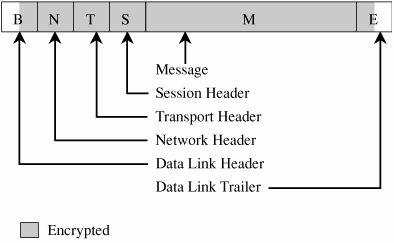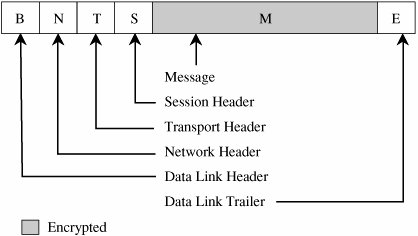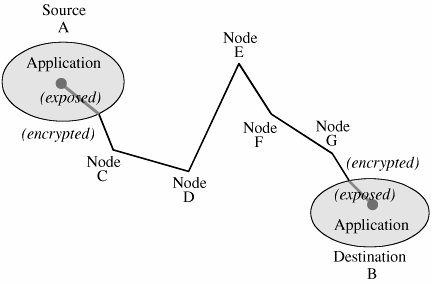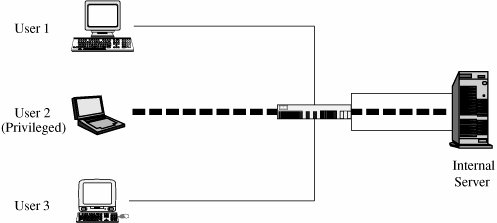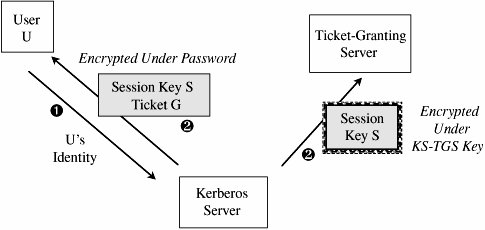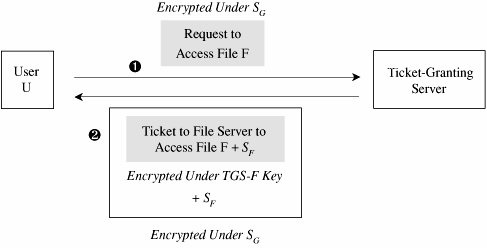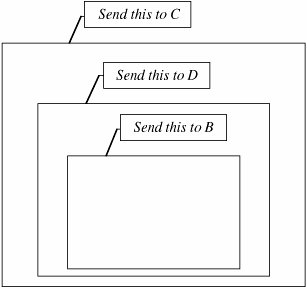Section 7.3. Network Security Controls
7.3. Network Security ControlsThe list of security attacks is long, and the news media carry frequent accounts of serious security incidents. From these, you may be ready to conclude that network security is hopeless. Fortunately, that is not the case. Previous chapters have presented several strategies for addressing security concerns, such as encryption for confidentiality and integrity, reference monitors for access control, and overlapping controls for defense in depth. These strategies are also useful in protecting networks. This section presents many excellent defenses available to the network security engineer. Subsequent sections provide detailed explanations for three particularly important controlsfirewalls, intrusion detection systems, and encrypted e-mail. Security Threat AnalysisRecall the three steps of a security threat analysis in other situations. First, we scrutinize all the parts of a system so that we know what each part does and how it interacts with other parts. Next, we consider possible damage to confidentiality, integrity, and availability. Finally, we hypothesize the kinds of attacks that could cause this damage. We can take the same steps with a network. We begin by looking at the individual parts of a network:
The local network is also connected to a
These functional needs are typical for network users. But now we look again at these parts, this time conjuring up the negative effects threat agents can cause. We posit a malicious agentcall him Hectorwho wants to attack networked communications between two users, Andy and Bo. What might Hector do?
We summarize these threats with a list:
Why are all these attacks possible? Size, anonymity, ignorance, misunderstanding, complexity, dedication, and programming all contribute. But we have help at hand; we look next at specific threats and their countermeasures. Later in this chapter we investigate how these countermeasures fit together into specific tools. Design and ImplementationThroughout this book we have discussed good principles of system analysis, design, implementation, and maintenance. Chapter 3, in particular, presented techniques that have been developed by the software engineering community to improve requirements, design, and code quality. Concepts from the work of the early trusted operating systems projects (presented in Chapter 5) have natural implications for networks as well. And assurance, also discussed in Chapter 5, relates to networked systems. In general, the Open Web Applications project [OWA02, OWA05] has documented many of the techniques people can use to develop secure web applications. Thus, having addressed secure programming from several perspectives already, we do not belabor the points now. ArchitectureAs with so many of the areas we have studied, planning can be the strongest control. In particular, when we build or modify computer-based systems, we can give some thought to their overall architecture and plan to "build in" security as one of the key constructs. Similarly, the architecture or design of a network can have a significant effect on its security. SegmentationJust as segmentation was a powerful security control in operating systems, it can limit the potential for harm in a network in two important ways: Segmentation reduces the number of threats, and it limits the amount of damage a single vulnerability can allow. Assume your network implements electronic commerce for users of the Internet. The fundamental parts of your network may be
If all these activities were to run on one machine, your network would be in trouble: Any compromise or failure of that machine would destroy your entire commerce capability. A more secure design uses multiple segments, as shown in Figure 7-19. Suppose one piece of hardware is to be a web server box exposed to access by the general public. To reduce the risk of attack from outside the system, that box should not also have other, more sensitive, functions on it, such as user authentication or access to a sensitive data repository. Separate segments and serverscorresponding to the principles of least privilege and encapsulationreduce the potential harm should any subsystem be compromised. Figure 7-19. Segmented Architecture. Separate access is another way to segment the network. For example, suppose a network is being used for three purposes: using the "live" production system, testing the next production version, and developing subsequent systems. If the network is well segmented, external users should be able to access only the live system, testers should access only the test system, and developers should access only the development system. Segmentation permits these three populations to coexist without risking that, for instance, a developer will inadvertently change the production system. RedundancyAnother key architectural control is redundancy: allowing a function to be performed on more than one node, to avoid "putting all the eggs in one basket." For example, the design of Figure 7-19 has only one web server; lose it and all connectivity is lost. A better design would have two servers, using what is called failover mode. In failover mode the servers communicate with each other periodically, each determining if the other is still active. If one fails, the other takes over processing for both of them. Although performance is cut approximately in half when a failure occurs, at least some processing is being done. Single Points of FailureIdeally, the architecture should make the network immune to failure. In fact, the architecture should at least make sure that the system tolerates failure in an acceptable way (such as slowing down but not stopping processing, or recovering and restarting incomplete transactions). One way to evaluate the network architecture's tolerance of failure is to look for single points of failure. That is, we should ask if there is a single point in the network that, if it were to fail, could deny access to all or a significant part of the network. So, for example, a single database in one location is vulnerable to all the failures that could affect that location. Good network design eliminates single points of failure. Distributing the databaseplacing copies of it on different network segments, perhaps even in different physical locationscan reduce the risk of serious harm from a failure at any one point. There is often substantial overhead in implementing such a design; for example, the independent databases must be synchronized. But usually we can deal with the failure-tolerant features more easily than with the harm caused by a failed single link. Architecture plays a role in implementing many other controls. We point out architectural features as we introduce other controls throughout the remainder of this chapter. Mobile AgentsMobile code and hostile agents are potential methods of attack, as described earlier in this chapter. However, they can also be forces for good. Good agents might look for unsecured wireless access, software vulnerabilities, or embedded malicious code. Schneider and Zhou [SCH05] investigate distributed trust, through a corps of communicating, state-sharing agents. The idea is straightforward: Just as with soldiers, you know some agents will be stopped and others will be subverted by the enemy, but some agents will remain intact. The corps can recover from Byzantine failures [LAM82]. Schneider and Zhou propose a design in which no one agent is critical to the overall success but the overall group can be trusted. EncryptionEncryption is probably the most important and versatile tool for a network security expert. We have seen in earlier chapters that encryption is powerful for providing privacy, authenticity, integrity, and limited access to data. Because networks often involve even greater risks, they often secure data with encryption, perhaps in combination with other controls. Before we begin to study the use of encryption to counter network security threats, let us consider these points. First, remember that encryption is not a panacea or silver bullet. A flawed system design with encryption is still a flawed system design. Second, notice that encryption protects only what is encrypted (which should be obvious but isn't). Data are exposed between a user's fingertips and the encryption process before they are transmitted, and they are exposed again once they have been decrypted on the remote end. The best encryption cannot protect against a malicious Trojan horse that intercepts data before the point of encryption. Finally, encryption is no more secure than its key management. If an attacker can guess or deduce a weak encryption key, the game is over. People who do not understand encryption sometimes mistake it for fairy dust to sprinkle on a system for magic protection. This book would not be needed if such fairy dust existed. In network applications, encryption can be applied either between two hosts (called link encryption) or between two applications (called end-to-end encryption). We consider each below. With either form of encryption, key distribution is always a problem. Encryption keys must be delivered to the sender and receiver in a secure manner. In this section, we also investigate techniques for safe key distribution in networks. Finally, we study a cryptographic facility for a network computing environment. Link EncryptionIn link encryption, data are encrypted just before the system places them on the physical communications link. In this case, encryption occurs at layer 1 or 2 in the OSI model. (A similar situation occurs with TCP/IP protocols.) Similarly, decryption occurs just as the communication arrives at and enters the receiving computer. A model of link encryption is shown in Figure 7-20. Figure 7-20. Link Encryption.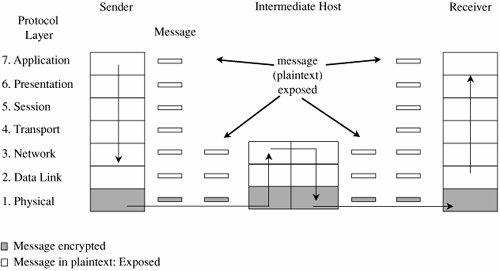 Encryption protects the message in transit between two computers, but the message is in plaintext inside the hosts. (A message in plaintext is said to be "in the clear.") Notice that because the encryption is added at the bottom protocol layer, the message is exposed in all other layers of the sender and receiver. If we have good physical security, we may not be too concerned about this exposure; the exposure occurs on the sender's or receiver's host or workstation, protected by alarms or locked doors, for example. Nevertheless, you should notice that the message is exposed in two layers of all intermediate hosts through which the message may pass. This exposure occurs because routing and addressing are not read at the bottom layer, but only at higher layers. The message is in the clear in the intermediate hosts, and one of these hosts may not be especially trustworthy. Link encryption is invisible to the user. The encryption becomes a transmission service performed by a low-level network protocol layer, just like message routing or transmission error detection. Figure 7-21 shows a typical link encrypted message, with the shaded fields encrypted. Because some of the data link header and trailer is applied before the block is encrypted, part of each of those blocks is shaded. As the message M is handled at each layer, header and control information is added on the sending side and removed on the receiving side. Hardware encryption devices operate quickly and reliably; in this case, link encryption is invisible to the operating system as well as to the operator. Figure 7-21. Message Under Link Encryption. Link encryption is especially appropriate when the transmission line is the point of greatest vulnerability. If all hosts on a network are reasonably secure but the communications medium is shared with other users or is not secure, link encryption is an easy control to use. End-to-End EncryptionAs its name implies, end-to-end encryption provides security from one end of a transmission to the other. The encryption can be applied by a hardware device between the user and the host. Alternatively, the encryption can be done by software running on the host computer. In either case, the encryption is performed at the highest levels (layer 7, application, or perhaps at layer 6, presentation) of the OSI model. A model of end-to-end encryption is shown in Figure 7-22. Figure 7-22. End-to-End Encryption. Since the encryption precedes all the routing and transmission processing of the layer, the message is transmitted in encrypted form throughout the network. The encryption addresses potential flaws in lower layers in the transfer model. If a lower layer should fail to preserve security and reveal data it has received, the data's confidentiality is not endangered. Figure 7-23 shows a typical message with end-to-end encryption, again with the encrypted field shaded. Figure 7-23. End-to-End Encrypted Message. When end-to-end encryption is used, messages sent through several hosts are protected. The data content of the message is still encrypted, as shown in Figure 7-24, and the message is encrypted (protected against disclosure) while in transit. Therefore, even though a message must pass through potentially insecure nodes (such as C through G) on the path between A and B, the message is protected against disclosure while in transit. Figure 7-24. Encrypted Message Passing Through a Host. Comparison of Encryption MethodsSimply encrypting a message is not absolute assurance that it will not be revealed during or after transmission. In many instances, however, the strength of encryption is adequate protection, considering the likelihood of the interceptor's breaking the encryption and the timeliness of the message. As with many aspects of security, we must balance the strength of protection with the likelihood of attack. (You will learn more about managing these risks in Chapter 8.) With link encryption, encryption is invoked for all transmissions along a particular link. Typically, a given host has only one link into a network, meaning that all network traffic initiated on that host will be encrypted by that host. But this encryption scheme implies that every other host receiving these communications must also have a cryptographic facility to decrypt the messages. Furthermore, all hosts must share keys. A message may pass through one or more intermediate hosts on the way to its final destination. If the message is encrypted along some links of a network but not others, then part of the advantage of encryption is lost. Therefore, link encryption is usually performed on all links of a network if it is performed at all. By contrast, end-to-end encryption is applied to "logical links," which are channels between two processes, at a level well above the physical path. Since the intermediate hosts along a transmission path do not need to encrypt or decrypt a message, they have no need for cryptographic facilities. Thus, encryption is used only for those messages and applications for which it is needed. Furthermore, the encryption can be done with software, so we can apply it selectively, one application at a time or even to one message within a given application. The selective advantage of end-to-end encryption is also a disadvantage regarding encryption keys. Under end-to-end encryption, there is a virtual cryptographic channel between each pair of users. To provide proper security, each pair of users should share a unique cryptographic key. The number of keys required is thus equal to the number of pairs of users, which is n * (n - 1)/2 for n users. This number increases rapidly as the number of users increases. However, this count assumes that single key encryption is used. With a public key system, only one pair of keys is needed per recipient. As shown in Table 7-5, link encryption is faster, easier for the user, and uses fewer keys. End-to-end encryption is more flexible, can be used selectively, is done at the user level, and can be integrated with the application. Neither form is right for all situations.
In some cases, both forms of encryption can be applied. A user who does not trust the quality of the link encryption provided by a system can apply end-to-end encryption as well. A system administrator who is concerned about the security of an end-to-end encryption scheme applied by an application program can also install a link encryption device. If both encryptions are relatively fast, this duplication of security has little negative effect. Virtual Private NetworksLink encryption can be used to give a network's users the sense that they are on a private network, even when it is part of a public network. For this reason, the approach is called a virtual private network (or VPN). Typically, physical security and administrative security are strong enough to protect transmission inside the perimeter of a network. Thus, the greatest exposure for a user is between the user's workstation or client and the perimeter of the host network or server. A firewall is an access control device that sits between two networks or two network segments. It filters all traffic between the protected or "inside" network and a less trustworthy or "outside" network or segment. (We examine firewalls in detail later in this chapter.) Many firewalls can be used to implement a VPN. When a user first establishes a communication with the firewall, the user can request a VPN session with the firewall. The user's client and the firewall negotiate a session encryption key, and the firewall and the client subsequently use that key to encrypt all traffic between the two. In this way, the larger network is restricted only to those given special access by the VPN. In other words, it feels to the user that the network is private, even though it is not. With the VPN, we say that the communication passes through an encrypted tunnel or tunnel. Establishment of a VPN is shown in Figure 7-25. Figure 7-25. Establishing a Virtual Private Network. Virtual private networks are created when the firewall interacts with an authentication service inside the perimeter. The firewall may pass user authentication data to the authentication server and, upon confirmation of the authenticated identity, the firewall provides the user with appropriate security privileges. For example, a known trusted person, such as an employee or a system administrator, may be allowed to access resources not available to general users. The firewall implements this access control on the basis of the VPN. A VPN with privileged access is shown in Figure 7-26. In that figure, the firewall passes to the internal server the (privileged) identity of User 2. Figure 7-26. VPN to Allow Privileged Access PKI and CertificatesA public key infrastructure, or PKI, is a process created to enable users to implement public key cryptography, usually in a large (and frequently, distributed) setting. PKI offers each user a set of services, related to identification and access control, as follows:
PKI is often considered to be a standard, but in fact it is a set of policies, products, and procedures that leave some room for interpretation. (Housley and Polk [HOU01b] describe both the technical parts and the procedural issues in developing a PKI.) The policies define the rules under which the cryptographic systems should operate. In particular, the policies specify how to handle keys and valuable information and how to match level of control to level of risk. The procedures dictate how the keys should be generated, managed, and used. Finally, the products actually implement the policies, and they generate, store, and manage the keys. PKI sets up entities, called certificate authorities, that implement the PKI policy on certificates. The general idea is that a certificate authority is trusted, so users can delegate the construction, issuance, acceptance, and revocation of certificates to the authority, much as one would use a trusted bouncer to allow only some people to enter a restricted nightclub. The specific actions of a certificate authority include the following:
The functions of a certificate authority can be done in-house or by a commercial service or a trusted third party. PKI also involves a registration authority that acts as an interface between a user and a certificate authority. The registration authority captures and authenticates the identity of a user and then submits a certificate request to the appropriate certificate authority. In this sense, the registration authority is much like the U.S. Postal Service; the postal service acts as an agent of the U.S. State Department to enable U.S. citizens to obtain passports (official U.S. authentication) by providing the appropriate forms, verifying identity, and requesting the actual passport (akin to a certificate) from the appropriate passport-issuing office (the certificate authority). As with passports, the quality of registration authority determines the level of trust that can be placed in the certificates that are issued. PKI fits most naturally in a hierarchically organized, centrally controlled organization, such as a government agency. PKI efforts are under way in many countries to enable companies and government agencies to implement PKI and interoperate. For example, a Federal PKI Initiative in the United States will eventually allow any U.S. government agency to send secure communication to any other U.S. government agency, when appropriate. The initiative also specifies how commercial PKI-enabled tools should operate, so agencies can buy ready-made PKI products rather than build their own. The European Union has a similar initiative (see www.europepki.org for more information.) Sidebar 7-8 describes the commercial use of PKI in a major U.K. bank. Major PKI solutions vendors include Baltimore Technologies, Northern Telecom/Entrust, and Identrus.
Most PKI processes use certificates that bind identity to a key. But research is being done to expand the notion of certificate to a broader characterization of credentials. For instance, a credit card company may be more interested in verifying your financial status than your identity; a PKI scheme may involve a certificate that is based on binding the financial status with a key. The Simple Distributed Security Infrastructure (SDSI) takes this approach, including identity certificates, group membership certificates, and name-binding certificates. As of this writing, there are drafts of two related standards: ANSI standard X9.45 and the Simple Public Key Infrastructure (SPKI); the latter has only a set of requirements and a certificate format. PKI is close to but not yet a mature process. Many issues must be resolved, especially since PKI has yet to be implemented commercially on a large scale. Table 7-6 lists several issues to be addressed as we learn more about PKI. However, some things have become clear. First, the certificate authority should be approved and verified by an independent body. The certificate authority's private key should be stored in a tamper-resistant security module. Then, access to the certificate and registration authorities should be tightly controlled, by means of strong user authentication such as smart cards.
The security involved in protecting the certificates involves administrative procedures. For example, more than one operator should be required to authorize certification requests. Controls should be put in place to detect hackers and prevent them from issuing bogus certificate requests. These controls might include digital signatures and strong encryption. Finally, a secure audit trail is necessary for reconstructing certificate information should the system fail and for recovering if a hacking attack does indeed corrupt the authentication process. SSH EncryptionSSH (secure shell) is a pair of protocols (versions 1 and 2), originally defined for Unix but also available under Windows 2000, that provides an authenticated and encrypted path to the shell or operating system command interpreter. Both SSH versions replace Unix utilities such as Telnet, rlogin, and rsh for remote access. SSH protects against spoofing attacks and modification of data in communication. The SSH protocol involves negotiation between local and remote sites for encryption algorithm (for example, DES, IDEA, AES) and authentication (including public key and Kerberos). SSL EncryptionThe SSL (Secure Sockets Layer) protocol was originally designed by Netscape to protect communication between a web browser and server. It is also known now as TLS, for transport layer security. SSL interfaces between applications (such as browsers) and the TCP/IP protocols to provide server authentication, optional client authentication, and an encrypted communications channel between client and server. Client and server negotiate a mutually supported suite of encryption for session encryption and hashing; possibilities include triple DES and SHA1, or RC4 with a 128-bit key and MD5. To use SSL, the client requests an SSL session. The server responds with its public key certificate so that the client can determine the authenticity of the server. The client returns part of a symmetric session key encrypted under the server's public key. Both the server and client compute the session key, and then they switch to encrypted communication, using the shared session key. The protocol is simple but effective, and it is the most widely used secure communication protocol on the Internet. However, remember that SSL protects only from the client's browser to the server's decryption point (which is often only to the server's firewall or, slightly stronger, to the computer that runs the web application). Data are exposed from the user's keyboard to the browser and throughout the recipient's company. Blue Gem Security has developed a product called LocalSSL that encrypts data after it has been typed until the operating system delivers it to the client's browser, thus thwarting any keylogging Trojan horse that has become implanted in the user's computer to reveal everything the user types. IPSecAs noted previously, the address space for the Internet is running out. As domain names and equipment proliferate, the original, 30-year-old, 32-bit address structure of the Internet is filling up. A new structure, called IPv6 (version 6 of the IP protocol suite), solves the addressing problem. This restructuring also offered an excellent opportunity for the Internet Engineering Task Force (IETF) to address serious security requirements. As a part of the IPv6 suite, the IETF adopted IPSec, or the IP Security Protocol Suite. Designed to address fundamental shortcomings such as being subject to spoofing, eavesdropping, and session hijacking, the IPSec protocol defines a standard means for handling encrypted data. IPSec is implemented at the IP layer, so it affects all layers above it, in particular TCP and UDP. Therefore, IPSec requires no change to the existing large number of TCP and UDP protocols. IPSec is somewhat similar to SSL, in that it supports authentication and confidentiality in a way that does not necessitate significant change either above it (in applications) or below it (in the TCP protocols). Like SSL, it was designed to be independent of specific cryptographic protocols and to allow the two communicating parties to agree on a mutually supported set of protocols. The basis of IPSec is what is called a security association, which is essentially the set of security parameters for a secured communication channel. It is roughly comparable to an SSL session. A security association includes
A host, such as a network server or a firewall, might have several security associations in effect for concurrent communications with different remote hosts. A security association is selected by a security parameter index (SPI), a data element that is essentially a pointer into a table of security associations. The fundamental data structures of IPSec are the AH (authentication header) and the ESP (encapsulated security payload). The ESP replaces (includes) the conventional TCP header and data portion of a packet, as shown in Figure 7-27. The physical header and trailer depend on the data link and physical layer communications medium, such as Ethernet. Figure 7-27. Packets: (a) Conventional Packet; (b) IPSec Packet.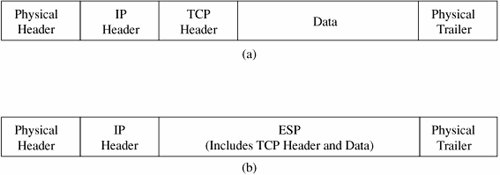 The ESP contains both an authenticated portion and an encrypted portion, as shown in Figure 7-28. The sequence number is incremented by one for each packet transmitted to the same address using the same SPI, to preclude packet replay attacks. The payload data is the actual data of the packet. Because some encryption or other security mechanisms require blocks of certain sizes, the padding factor and padding length fields contain padding and the amount of padding to bring the payload data to an appropriate length. The next header indicates the type of payload data. The authentication field is used for authentication of the entire object. Figure 7-28. Encapsulated Security Packet.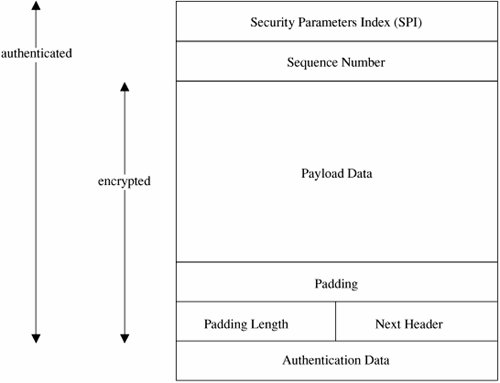 As with most cryptographic applications, the critical element is key management. IPSec addresses this need with ISAKMP or Internet Security Association Key Management Protocol. Like SSL, ISAKMP requires that a distinct key be generated for each security association. The ISAKMP protocol is simple, flexible, and scalable. In IPSec, ISAKMP is implemented through IKE or ISAKMP key exchange. IKE provides a way to agree on and manage protocols, algorithms, and keys. For key exchange between unrelated parties IKE uses the DiffieHellman scheme (also described in Chapter 2). In DiffieHellman, each of the two parties, X and Y, chooses a large prime and sends a number g raised to the power of the prime to the other. That is, X sends gx and Y sends gy. They both raise what they receive to the power they kept: Y raises gx to (gx)y and X raises gy to (gy)x, which are both the same; voilà, they share a secret (gx)y = (gy)x. (The computation is slightly more complicated, being done in a finite field mod(n), so an attacker cannot factor the secret easily.) With their shared secret, the two parties now exchange identities and certificates to authenticate those identities. Finally, they derive a shared cryptographic key and enter a security association. The key exchange is very efficient: The exchange can be accomplished in two messages, with an optional two more messages for authentication. Because this is a public key method, only two keys are needed for each pair of communicating parties. IKE has submodes for authentication (initiation) and for establishing new keys in an existing security association. IPSec can establish cryptographic sessions with many purposes, including VPNs, applications, and lower-level network management (such as routing). The protocols of IPSec have been published and extensively scrutinized. Work on the protocols began in 1992. They were first published in 1995, and they were finalized in 1998 (RFCs 24012409) [KEN98]. Signed CodeAs we have seen, someone can place malicious active code on a web site to be downloaded by unsuspecting users. Running with the privilege of whoever downloads it, such active code can do serious damage, from deleting files to sending e-mail messages to fetching Trojan horses to performing subtle and hard-to-detect mischief. Today's trend is to allow applications and updates to be downloaded from central sites, so the risk of downloading something malicious is growing. A partialnot completeapproach to reducing this risk is to use signed code. A trustworthy third party appends a digital signature to a piece of code, supposedly connoting more trustworthy code. A signature structure in a PKI helps to validate the signature. Who might the trustworthy party be? A well-known manufacturer would be recognizable as a code signer. But what of the small and virtually unknown manufacturer of a device driver or a code add-in? If the code vendor is unknown, it does not help that the vendor signs its own code; miscreants can post their own signed code, too. In March 2001, Verisign announced it had erroneously issued two code-signing certificates under the name of Microsoft Corp. to someone who purported to bebut was nota Microsoft employee. These certificates were in circulation for almost two months before the error was detected. Even after Verisign detected the error and canceled the certificates, someone would know the certificates had been revoked only by checking Verisign's list. Most people would not question a code download signed by Microsoft. Encrypted E-mailAn electronic mail message is much like the back of a post card. The mail carrier (and everyone in the postal system through whose hands the card passes) can read not just the address but also everything in the message field. To protect the privacy of the message and routing information, we can use encryption to protect the confidentiality of the message and perhaps its integrity. As we have seen in several other applications, the encryption is the easy part; key management is the more difficult issue. The two dominant approaches to key management are the use of a hierarchical, certificate-based PKI solution for key exchange and the use of a flat, individual-to-individual exchange method. The hierarchical method is called S/MIME and is employed by many commercial mail-handling programs, such as Microsoft Exchange or Eudora. The individual method is called PGP and is a commercial add-on. We look more carefully at encrypted e-mail in a later section of this chapter. Content IntegrityContent integrity comes as a bonus with cryptography. No one can change encrypted data in a meaningful way without breaking the encryption. This does not say, however, that encrypted data cannot be modified. Changing even one bit of an encrypted data stream affects the result after decryption, often in a way that seriously alters the resulting plaintext. We need to consider three potential threats:
Encryption addresses the first of these threats very effectively. To address the others, we can use other controls. Error Correcting CodesWe can use error detection and error correction codes to guard against modification in a transmission. The codes work as their names imply: Error detection codes detect when an error has occurred, and error correction codes can actually correct errors without requiring retransmission of the original message. The error code is transmitted along with the original data, so the recipient can recompute the error code and check whether the received result matches the expected value. The simplest error detection code is a parity check. An extra bit is added to an existing group of data bits depending on their sum or an exclusive OR. The two kinds of parity are called even and odd. With even parity the extra bit is 0 if the sum of the data bits is even and 1 if the sum is odd; that is, the parity bit is set so that the sum of all data bits plus the parity bit is even. Odd parity is the same except the sum is odd. For example, the data stream 01101101 would have an even parity bit of 1 (and an odd parity bit of 0) because 0+1+1+0+1+1+0+1 = 5 + 1 = 6 (or 5 + 0 = 5 for odd parity). A parity bit can reveal the modification of a single bit. However, parity does not detect two-bit errorscases in which two bits in a group are changed. That is, the use of a parity bit relies on the assumption that single-bit errors will occur infrequently, so it is very unlikely that two bits would be changed. Parity signals only that a bit has been changed; it does not identify which bit has been changed. There are other kinds of error detection codes, such as hash codes and Huffman codes. Some of the more complex codes can detect multiple-bit errors (two or more bits changed in a data group) and may be able to pinpoint which bits have been changed. Parity and simple error detection and correction codes are used to detect nonmalicious changes in situations in which there may be faulty transmission equipment, communications noise and interference, or other sources of spurious changes to data. Cryptographic ChecksumMalicious modification must be handled in a way that prevents the attacker from modifying the error detection mechanism as well as the data bits themselves. One way to do this is to use a technique that shrinks and transforms the data, according to the value of the data bits. To see how such an approach might work, consider an error detection code as a many-to-one transformation. That is, any error detection code reduces a block of data to a smaller digest whose value depends on each bit in the block. The proportion of reduction (that is, the ratio of original size of the block to transformed size) relates to the code's effectiveness in detecting errors. If a code reduces an 8-bit data block to a 1-bit result, then half of the 28 input values map to 0 and half to 1, assuming a uniform distribution of outputs. In other words, there are 28/2 = 27 = 128 different bit patterns that all produce the same 1-bit result. The fewer inputs that map to a particular output, the fewer ways the attacker can change an input value without affecting its output. Thus, a 1-bit result is too weak for many applications. If the output is three bits instead of one, then each output result comes from 28/23 or 25 = 32 inputs. The smaller number of inputs to a given output is important for blocking malicious modification. A cryptographic checksum (sometimes called a message digest) is a cryptographic function that produces a checksum. The cryptography prevents the attacker from changing the data block (the plaintext) and also changing the checksum value (the ciphertext) to match. Two major uses of cryptographic checksums are code tamper protection and message integrity protection in transit. For code protection, a system administrator computes the checksum of each program file on a system and then later computes new checksums and compares the values. Because executable code usually does not change, the administrator can detect unanticipated changes from, for example, malicious code attacks. Similarly, a checksum on data in communication identifies data that have been changed in transmission, maliciously or accidentally. Strong AuthenticationAs we have seen in earlier chapters, operating systems and database management systems enforce a security policy that specifies whowhich individuals, groups, subjectscan access which resources and objects. Central to that policy is authentication: knowing and being assured of the accuracy of identities. Networked environments need authentication, too. In the network case, however, authentication may be more difficult to achieve securely because of the possibility of eavesdropping and wiretapping, which are less common in nonnetworked environments. Also, both ends of a communication may need to be authenticated to each other: Before you send your password across a network, you want to know that you are really communicating with the remote host you expect. Lampson [LAM00] presents the problem of authentication in autonomous, distributed systems; the real problem, he points out, is how to develop trust of network entities with which you have no basis for a relationship. Let us look more closely at authentication methods appropriate for use in networks. One-Time PasswordThe wiretap threat implies that a password could be intercepted from a user who enters a password across an unsecured network. A one-time password can guard against wiretapping and spoofing of a remote host. As the name implies, a one-time password is good for one use only. To see how it works, consider the easiest case, in which the user and host both have access to identical lists of passwords, like the one-time pad for cryptography from Chapter 2. The user would enter the first password for the first login, the next one for the next login, and so forth. As long as the password lists remained secret and as long as no one could guess one password from another, a password obtained through wiretapping would be useless. However, as with the one-time cryptographic pads, humans have trouble maintaining these password lists. To address this problem, we can use a password token, a device that generates a password that is unpredictable but that can be validated on the receiving end. The simplest form of password token is a synchronous one, such as the SecurID device from RSA Security, Inc. This device displays a random number, generating a new number every minute. Each user is issued a different device (that generates a different random number sequence). The user reads the number from the device's display and types it in as a one-time password. The computer on the receiving end executes the algorithm to generate the password appropriate for the current minute; if the user's password matches the one computed remotely, the user is authenticated. Because the devices may get out of alignment if one clock runs slightly faster than the other, these devices use fairly natural rules to account for minor drift. What are the advantages and disadvantages of this approach? First, it is easy to use. It largely counters the possibility of a wiretapper reusing a password. With a strong password-generating algorithm, it is immune to spoofing. However, the system fails if the user loses the generating device or, worse, if the device falls into an attacker's hands. Because a new password is generated only once a minute, there is a small (one-minute) window of vulnerability during which an eavesdropper can reuse an intercepted password. ChallengeResponse SystemsTo counter the loss and reuse problems, a more sophisticated one-time password scheme uses challenge and response, as we first studied in Chapter 4. A challenge and response device looks like a simple pocket calculator. The user first authenticates to the device, usually by means of a PIN. The remote system sends a random number, called the "challenge," which the user enters into the device. The device responds to that number with another number, which the user then transmits to the system. The system prompts the user with a new challenge for each use. Thus, this device eliminates the small window of vulnerability in which a user could reuse a time-sensitive authenticator. A generator that falls into the wrong hands is useless without the PIN. However, the user must always have the response generator to log in, and a broken device denies service to the user. Finally, these devices do not address the possibility of a rogue remote host. Digital Distributed AuthenticationIn the 1980s, Digital Equipment Corporation recognized the problem of needing to authenticate nonhuman entities in a computing system. For example, a process might retrieve a user query, which it then reformats, perhaps limits, and submits to a database manager. Both the database manager and the query processor want to be sure that a particular communication channel is authentic between the two. Neither of these servers is running under the direct control or supervision of a human (although each process was, of course, somehow initiated by a human). Human forms of access control are thus inappropriate. Digital [GAS89, GAS90] created a simple architecture for this requirement, effective against the following threats:
The architecture assumes that each server has its own private key and that the corresponding public key is available to or held by every other process that might need to establish an authenticated channel. To begin an authenticated communication between server A and server B, A sends a request to B, encrypted under B's public key. B decrypts the request and replies with a message encrypted under A's public key. To avoid replay, A and B can append a random number to the message to be encrypted. A and B can establish a private channel by one of them choosing an encryption key (for a secret key algorithm) and sending it to the other in the authenticating message. Once the authentication is complete, all communication under that secret key can be assumed to be as secure as was the original dual public key exchange. To protect the privacy of the channel, Gasser recommends a separate cryptographic processor, such as a smart card, so that private keys are never exposed outside the processor. Two implementation difficulties remain to be solved: (a) How can a potentially large number of public keys be distributed and (b) how can the public keys be distributed in a way that ensures the secure binding of a process with the key? Digital recognized that a key server (perhaps with multiple replications) was necessary to distribute keys. The second difficulty is addressed with certificates and a certification hierarchy, as described in Chapter 2. Both of these design decisions are to a certain degree implied by the nature of the rest of the protocol. A different approach was taken by Kerberos, as we see in the following sections. KerberosAs we introduced in Chapter 4, Kerberos is a system that supports authentication in distributed systems. Originally designed to work with secret key encryption, Kerberos, in its latest version, uses public key technology to support key exchange. The Kerberos system was designed at Massachusetts Institute of Technology [STE88, KOH93]. Kerberos is used for authentication between intelligent processes, such as client-to-server tasks, or a user's workstation to other hosts. Kerberos is based on the idea that a central server provides authenticated tokens, called tickets, to requesting applications. A ticket is an unforgeable, nonreplayable, authenticated object. That is, it is an encrypted data structure naming a user and a service that user is allowed to obtain. It also contains a time value and some control information. The first step in using Kerberos is to establish a session with the Kerberos server, as shown in Figure 7-29. A user's workstation sends the user's identity to the Kerberos server when a user logs in. The Kerberos server verifies that the user is authorized. The Kerberos server sends two messages:
Figure 7-29. Initiating a Kerberos Session. If the workstation can decrypt E(SG + TG, pw) by using pw, the password typed by the user, then the user has succeeded in an authentication with the workstation. Notice that passwords are stored at the Kerberos server, not at the workstation, and that the user's password did not have to be passed across the network, even in encrypted form. Holding passwords centrally but not passing them across the network is a security advantage. Next, the user will want to exercise some other services of the distributed system, such as accessing a file. Using the key SG provided by the Kerberos server, the user U requests a ticket to access file F from the ticket-granting server. As shown in Figure 7-30, after the ticket-granting server verifies U's access permission, it returns a ticket and a session key. The ticket contains U's authenticated identity (in the ticket U obtained from the Kerberos server), an identification of F (the file to be accessed), the access rights (for example, to read), a session key SF for the file server to use while communicating this file to U, and an expiration date for the ticket. The ticket is encrypted under a key shared exclusively between the ticket-granting server and the file server. This ticket cannot be read, modified, or forged by the user U (or anyone else). The ticket-granting server must, therefore, also provide U with a copy of SF, the session key for the file server. Requests for access to other services and servers are handled similarly. Figure 7-30. Obtaining a Ticket to Access a File. Kerberos was carefully designed to withstand attacks in distributed environments:
Kerberos is not a perfect answer to security problems in distributed systems.
Figure 7-31. Access to Services and Servers in Kerberos.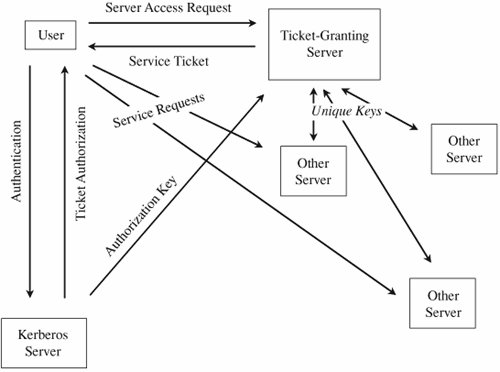 Access ControlsAuthentication deals with the who of security policy enforcement; access controls enforce the what and how. ACLs on RoutersRouters perform the major task of directing network traffic either to subnetworks they control or to other routers for subsequent delivery to other subnetworks. Routers convert external IP addresses into internal MAC addresses of hosts on a local subnetwork. Suppose a host is being spammed (flooded) with packets from a malicious rogue host. Routers can be configured with access control lists to deny access to particular hosts from particular hosts. So, a router could delete all packets with a source address of the rogue host and a destination address of the target host. This approach has three problems, however. First, routers in large networks perform a lot of work: They have to handle every packet coming into and going out of the network. Adding ACLs to the router requires the router to compare every packet against the ACLs. One ACL adds work, degrading the router's performance; as more ACLs are added, the router's performance may become unacceptable. The second problem is also an efficiency issue: Because of the volume of work they perform, routers are designed to perform only essential services. Logging of activity is usually not done on a router because of the volume of traffic and the performance penalty logging would entail. With ACLs, it would be useful to know how many packets were being deleted, to know if a particular ACL could be removed (thereby improving performance). But without logging it is impossible to know whether an ACL is being used. These two problems together imply that ACLs on routers are most effective against specific known threats but that they should not be used indiscriminately. The final limitation on placing ACLs on routers concerns the nature of the threat. A router inspects only source and destination addresses. An attacker usually does not reveal an actual source address. To reveal the real source address would be equivalent to a bank robber's leaving his home address and a description of where he plans to store the stolen money. Because someone can easily forge any source address on a UDP datagram, many attacks use UDP protocols with false source addresses so that the attack cannot be blocked easily by a router with an ACL. Router ACLs are useful only if the attacker sends many datagrams with the same forged source address. In principle, a router is an excellent point of access control because it handles every packet coming into and going out of a subnetwork. In specific situations, primarily for internal subnetworks, ACLs can be used effectively to restrict certain traffic flows, for example, to ensure that only certain hosts (addresses) have access to an internal network management subnetwork. But for large-scale, general traffic screening, routers are less useful than firewalls. FirewallsA firewall does the screening that is less appropriate for a router to do. A router's primary function is addressing, whereas a firewall's primary function is filtering. Firewalls can also do auditing. Even more important, firewalls can examine an entire packet's contents, including the data portion, whereas a router is concerned only with source and destination MAC and IP addresses. Because they are an extremely important network security control, we study firewalls in an entire section later in this chapter. Wireless SecurityBecause wireless computing is so exposed, it requires measures to protect communications between a computer (called the client) and a wireless base station or access point. Remembering that all these communications are on predefined radio frequencies, you can expect an eavesdropping attacker to try to intercept and impersonate. Pieces to protect are finding the access point, authenticating the remote computer to the access point, and vice versa, and protecting the communication stream. SSIDAs described earlier in this chapter, the Service Set Identifier or SSID is the identification of an access point; it is a string of up to 32 characters. Obviously the SSIDs need to be unique in a given area to distinguish one wireless network from another. The factory-installed default for early versions of wireless access points was not unique, such as "wireless," "tsunami" or "Linksys" (a brand name); now most factory defaults are a serial number unique to the device. A client and an access point engage in a handshake to locate each other: Essentially the client says, "I am looking to connect to access point S" and the access point says, "I am access point S; connect to me." The order of these two steps is important. In what is called "open mode," an access point can continually broadcast its appeal, indicating that it is open for the next step in establishing a connection. Open mode is a poor security practice because it advertises the name of an access point to which an attacker might attach. "Closed" or "stealth mode" reverses the order of the protocol: The client must send a signal seeking an access point with a particular SSID before the access point responds to that one query with an invitation to connect. But closed mode does not prevent knowledge of the SSID. The initial exchange "looking for S," "I am S" occurs in the clear and is available to anyone who uses a sniffer to intercept wireless communications in range. Thus, anyone who sniffs the SSID can save the SSID (which is seldom changed in practice) to use later. WEPThe second step in securing a wireless communication involves use of encryption. The original 802.11 wireless standard relied upon a cryptographic protocol called wired equivalent privacy or WEP. WEP was meant to provide users privacy equivalent to that of a dedicated wire, that is, immunity to most eavesdropping and impersonation attacks. WEP uses an encryption key shared between the client and the access point. To authenticate a user, the access point sends a random number to the client, which the client encrypts using the shared key and returns to the access point. From that point on, the client and access point are authenticated and can communicate using their shared encryption key. Several problems exist with this seemingly simple approach. First, the WEP standard uses either a 64- or 128-bit encryption key. The user enters the key in any convenient form, usually in hexadecimal or as an alphanumeric string that is converted to a number. Entering 64 or 128 bits in hex requires choosing and then typing 16 or 32 symbols correctly for the client and access point. Not surprisingly, hex strings like C0DE C0DE… (that is a zero between C and D) are common. Passphrases are vulnerable to a dictionary attack. Even if the key is strong, it really has an effective length of only 40 or 104 bits because of the way it is used in the algorithm. A brute force attack against a 40-bit key succeeds quickly. Even for the 104-bit version, flaws in the RC4 algorithm and its use (see [BOR01, FLU01, and ARB02]) defeat WEP security. Several tools, starting with WEPCrack and AirSnort, allow an attacker to crack a WEP encryption, usually in a few minutes. At a 2005 conference, the FBI demonstrated the ease with which a WEP-secured wireless session can be broken. For these reasons, in 2001 the IEEE began design of a new authentication and encryption scheme for wireless. Unfortunately, some wireless devices still on the market allow only the false security of WEP. WPA and WPA2The alternative to WEP is WiFi Protected Access or WPA, approved in 2003. The IEEE standard 802.11i is now known as WPA2, approved in 2004, and is an extension of WPA. How does WPA improve upon WEP? First, WEP uses an encryption key that is unchanged until the user enters a new key at the client and access point. Cryptologists hate unchanging encryption keys because a fixed key gives the attacker a large amount of ciphertext to try to analyze and plenty of time in which to analyze it. WPA has a key change approach, called Temporal Key Integrity Program (TKIP), by which the encryption key is changed automatically on each packet. Second, WEP uses the encryption key as an authenticator, albeit insecurely. WPA employs the extensible authentication protocol (EAP) by which authentication can be done by password, token, certificate, or other mechanism. For small network (home) users, this probably still means a shared secret, which is not ideal. Users are prone to selecting weak keys, such as short numbers or pass phrases subject to a dictionary attack. The encryption algorithm for WEP is RC4, which has cryptographic flaws both in key length and design [ARB02]. In WEP the initialization vector for RC4 is only 24 bits, a size so small that collisions commonly occur; furthermore, there is no check against initialization vector reuse. WPA2 adds AES as a possible encryption algorithm (although RC4 is also still supported for compatibility reasons). WEP includes a 32-bit integrity check separate from the data portion. But because the WEP encryption is subject to cryptanalytic attack [FLU01], the integrity check was also subject, so an attacker could modify content and the corresponding check without having to know the associated encryption key [BOR01]. WPA includes a 64-bit integrity check that is encrypted. The setup protocol for WPA and WPA2 is much more robust than that for WEP. Setup for WPA involves three protocol steps: authentication, a four-way handshake (to ensure that the client can generate cryptographic keys and to generate and install keys for both encryption and integrity on both ends), and an optional group key handshake (for multicast communication.) A good overview of the WPA protocols is in [LEH05]. WPA and WPA2 address the security deficiencies known in WEP. Arazi et al. [ARA05] make a strong case for public key cryptography in wireless sensor networks, and a similar argument can be made for other wireless applications (although the heavier computation demands of public key encryption is a limiting factor on wireless devices with limited processor capabilities.) Alarms and AlertsThe logical view of network protection looks like Figure 7-32, in which both a router and a firewall provide layers of protection for the internal network. Now let us add one more layer to this defense. Figure 7-32. Layered Network Protection. An intrusion detection system is a device that is placed inside a protected network to monitor what occurs within the network. If an attacker passes through the router and passes through the firewall, an intrusion detection system offers the opportunity to detect the attack at the beginning, in progress, or after it has occurred. Intrusion detection systems activate an alarm, which can take defensive action. We study intrusion detection systems in more detail later in this chapter. HoneypotsHow do you catch a mouse? You set a trap with bait (food the mouse finds attractive) and catch the mouse after it is lured into the trap. You can catch a computer attacker the same way. In a very interesting book, Cliff Stoll [STO89] details the story of attracting and monitoring the actions of an attacker. Cheswick [CHE90, CHE02] and Bellovin [BEL92c] tell a similar story. These two cases describe the use of a honeypot: a computer system open to attackers. You put up a honeypot for several reasons:
A honeypot has no special features. It is just a computer system or a network segment, loaded with servers and devices and data. It may be protected with a firewall, although you want the attackers to have some access. There may be some monitoring capability, done carefully so that the monitoring is not evident to the attacker. The two difficult features of a honeypot are putting up a believable, attractive false environment and confining and monitoring the attacker surreptitiously. Spitzner [SPI02, SPI03a] has done extensive work developing and analyzing honeypots. He thinks like the attacker, figuring what the attacker will want to see in an invaded computer, but as McCarty [MCC03] points out, it is always a race between attacker and defender. Spitzner also tries to move much of his data off the target platform so that the attacker will not be aware of the analysis and certainly not be able to modify or erase the data gathered. Raynal [RAY04a. RAY04b] discusses how to analyze the data collected. Traffic Flow SecuritySo far, we have looked at controls that cover the most common network threats: cryptography for eavesdropping, authentication methods for impersonation, intrusion detection systems for attacks in progress, architecture for structural flaws. Earlier in this chapter, we listed threats, including a threat of traffic flow inference. If the attacker can detect an exceptional volume of traffic between two points, the attacker may infer the location of an event about to occur. The countermeasure to traffic flow threats is to disguise the traffic flow. One way to disguise traffic flow, albeit costly and perhaps crude, is to ensure a steady volume of traffic between two points. If traffic between A and B is encrypted so that the attacker can detect only the number of packets flowing, A and B can agree to pass recognizable (to them) but meaningless encrypted traffic. When A has much to communicate to B, there will be few meaningless packets; when communication is light, A will pad the traffic stream with many spurious packets. A more sophisticated approach to traffic flow security is called onion routing [SYV97]. Consider a message that is covered in multiple layers, like the layers of an onion. A wants to send a message to B but doesn't want anyone in or intercepting traffic on the network to know A is communicating with B. So A takes the message to B, wraps it in a package for D to send to B. Then, A wraps that package in another package for C to send to D. Finally, A sends this package to C. This process is shown in Figure 7-33. The internal wrappings are all encrypted under a key appropriate for the intermediate recipient. Figure 7-33. Onion Routing. Receiving the package, C knows it came from A, although C does not know if A is the originator or an intermediate point. C then unwraps the outer layer and sees it should be sent to D. At this point, C cannot know if D is the final recipient or merely an intermediary. C sends the message to D, who unwraps the next layer. D knows neither where the package originally came from nor where its final destination is. D forwards the package to B, its ultimate recipient. With this scheme, any intermediate recipientsthose other than the original sender and ultimate receiverknow neither where the package originated nor where it will end up. This scheme provides confidentiality of content, source, destination, and routing. Controls ReviewAt the end of our earlier discussion on threats in networks, we listed in Table 7-4 many of the vulnerabilities present in networks. Now that we have surveyed the controls available for networks, we repeat that table as Table 7-7, adding a column to show the controls that can protect against each vulnerability. (Note: This table is not exhaustive; other controls can be used against some of the vulnerabilities.)
As Table 7-7 shows, network security designers have many successful tools at their disposal. Some of these, such as encryption, access control and authentication, and programming controls, are familiar from previous chapters in this book. But three are specific to networked settings, and we explore them now in greater depth: firewalls, intrusion detection systems, and encrypted e-mail. Firewalls control traffic flow into and out of protected network segments. Intrusion detection systems monitor traffic within a network to spot potential attacks under way or about to occur. And encrypted email uses encryption to enhance the confidentiality or authenticity of e-mail messages. | |||||||||||||||||||||||||||||||||||||||||||||||||||||||||||||||||||||||||||||||||||||||||||||||||||||||||||||||||||||||||||||||||||||||||||||||||||||||||||||||||||||||||||||||||||||||
EAN: 2147483647
Pages: 171
